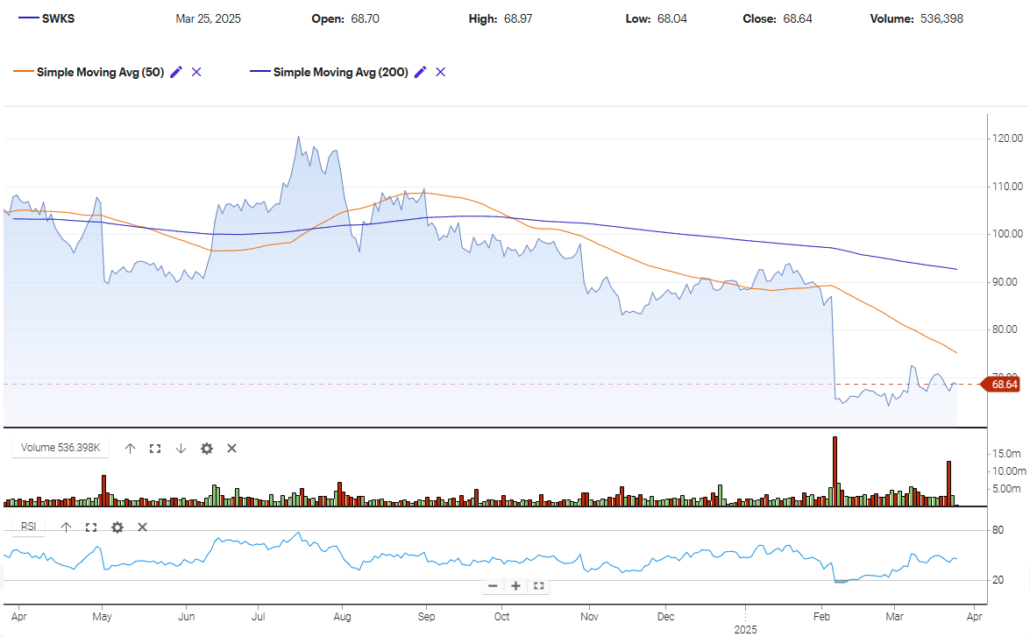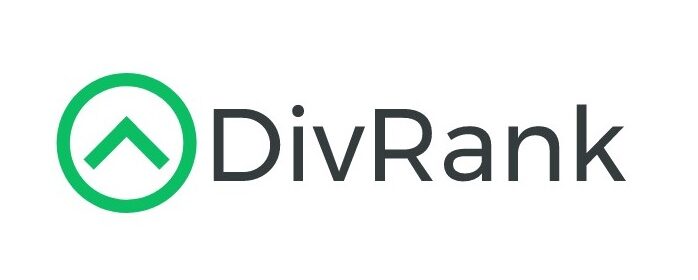Updated 3/26
Skyworks Solutions, Inc. is a name that resonates with anyone keeping tabs on the semiconductor industry. Known for supplying critical components used in smartphones, wireless infrastructure, and IoT devices, the company has long been tied to the broader tech cycle—particularly Apple’s supply chain. Over the years, Skyworks has quietly evolved from a growth darling into a mature, cash-generating business. And with that shift has come a growing appeal for income investors. Now, with the stock trading near multi-year lows, the dividend yield is beginning to catch more eyes.
Recent Events
Skyworks has seen its market cap fall sharply over the last year—from over $18 billion down to just under $11 billion. The reasons are straightforward: declining sales, earnings pressure, and a broader de-rating of semiconductor stocks as investors rotate out of tech. Most recently, the company closed at $67.60 on March 26, down nearly 38% from its 52-week high of $120.86.
The numbers tell the story of a business going through a reset. Quarterly revenue declined 11.1% year-over-year, while earnings shrank by 30%. These aren’t the kind of figures that instill immediate confidence, but for dividend investors, the focus isn’t always on near-term growth—it’s about sustainability and income consistency.
Skyworks still brings in strong operating cash flow, with $1.43 billion over the trailing twelve months, and it continues to return capital to shareholders through dividends. That consistency amid turbulence could be enough to keep long-term income investors interested.
Key Dividend Metrics
📈 Dividend Yield: 4.14% (Forward)
💵 Annual Dividend: $2.80 per share
📅 Trailing Dividend: $2.76
🧮 Payout Ratio: 84.92%
📅 Ex-Dividend Date: February 24, 2025
🔁 Five-Year Average Yield: 2.03%
🏦 Payment Frequency: Quarterly
⚖️ Last Stock Split: 2-for-1 on April 20, 2000
Dividend Overview
A 4.14% forward dividend yield puts Skyworks firmly in high-yield territory—especially for a tech stock. That’s double its five-year average, a clear sign that the dividend yield is being driven by price weakness rather than payout growth. From a contrarian perspective, that could present an opportunity, but it also warrants a closer look at the company’s ability to keep those payouts coming.
The company’s $2.80 annual dividend is generous by sector standards, but the 84.92% payout ratio raises a flag. That level of payout suggests there’s not a lot of margin for error if earnings continue to decline. The dividend hasn’t been cut, and there’s been no indication that a reduction is on the table—but it’s a figure that needs to be monitored closely going forward.
Dividend Growth and Safety
Skyworks has steadily increased its dividend over the past several years, transitioning into more of an income-generating stock as its core business matured. The dividend rose from $2.00 in 2020 to the current $2.80, representing a compound annual growth rate that shows real commitment to returning capital to shareholders.
That said, the pace of dividend growth may not be sustainable unless earnings rebound. With a payout ratio closing in on 85%, Skyworks is already using a significant portion of its profits to fund dividends. However, thanks to strong cash flow—$972 million in free cash flow last year—the company still has the firepower to maintain its current payout.
This dividend doesn’t seem at immediate risk, but any further deterioration in profitability would likely cap future growth. Investors who value income stability above dividend increases might still find comfort here, but growth-oriented income seekers may want to temper expectations.
Chart Analysis

Market Phase Overview
Skyworks Solutions (SWKS) is currently showing clear characteristics of a markdown phase following a drawn-out distribution. From mid-2024 into early Q4, the stock moved within a relatively tight range, hovering around the $100 level. During this time, price action showed signs of weakening momentum—particularly as it failed to make new highs and began forming lower highs into October.
What followed was a breakdown below the support near the $90–$92 range, which then accelerated selling pressure sharply in early 2025. This breakdown, combined with increased volume, signaled the start of the markdown phase.
Moving Averages
The 50-day simple moving average (orange line) has sharply turned lower and remains well below the 200-day moving average (blue line). This alignment confirms a strong bearish trend. The 200-day has been trending downward for months, and the 50-day crossed below it well before the recent breakdown, forming a classic death cross.
Notably, the price is significantly below both moving averages. This kind of gap between price and longer-term averages typically suggests a deeply entrenched downtrend, with little indication yet of any reversal attempt.
Volume Analysis
Volume has remained mostly steady through the drawdown, but there are notable spikes on down days—particularly around the mid-January and early March declines. These high-volume selloffs suggest institutional distribution rather than random retail selling.
Recent rallies in March occurred on relatively lower volume, which shows weak buying conviction. The strong selling volume, especially during the breakdown, and the lack of follow-through on the bounce indicate continued bearish sentiment.
RSI and Momentum
The relative strength index (RSI) dipped below the 30 level during the February lows, which flagged oversold conditions. Since then, RSI has moved modestly higher but still remains under the 50 mark, suggesting the stock is attempting a base but remains in weak territory.
Momentum has not shifted convincingly to the upside. The short-term RSI uptick shows a slight bounce attempt, but the absence of strong buying volume supports the idea that this is more of a bear flag than the beginning of a reversal.
Recent Candlestick Behavior
Looking at the last five candles, the price has hovered around the $68 to $70 zone, showing short-bodied candles with both upper and lower wicks. This type of price action points to indecision and a battle between buyers trying to hold the level and sellers capping any short-term rallies.
There is no dominant bullish candle among the five. The occasional upper wicks show that each push higher is being sold into, and the tight range suggests a lack of conviction from bulls. Combined with the broader context of the markdown phase, these candles reinforce the idea that the stock remains under pressure.
Volume Clusters and Price Structure
The volume profile also hints at areas of congestion. There’s a clear spike in volume during the breakdown, which typically forms a new supply zone. Unless price can push above that breakdown area—likely around the $75–$78 zone—with strong volume, it’s likely to remain capped in the short term.
Analyst Ratings
📉 Skyworks Solutions, Inc. (SWKS) has come under pressure recently with a wave of analyst downgrades and trimmed price targets. As of the latest data, the stock is trading around $67.60, and sentiment from the analyst community has clearly shifted toward caution.
🎯 The average 12-month price target sits at $83.78, with the highest estimate reaching $110 and the lowest at $60. This implies a potential upside of roughly 24% from current levels. The overall consensus rating is leaning toward “Reduce,” with the breakdown showing 3 analysts suggesting “Sell,” 19 maintaining a “Hold,” and just 1 recommending a “Buy.”
🔻 A handful of firms have recently updated their views:
- 🟡 Goldman Sachs kept its “Neutral” stance but dropped the price target from $92 to $70.
- 🟠 Stifel shifted from “Buy” to “Hold” and lowered the target from $105 to $62.
- 🔵 Morgan Stanley held its “Equal-Weight” rating, trimming its target from $87 to $72.
- 🟣 Piper Sandler stayed “Neutral,” adjusting its target from $85 to $70.
- 🔴 Rosenblatt went from “Buy” to “Neutral,” bringing its target down from $120 to $80.
📦 The driving force behind this wave of downgrades is Skyworks’ expected reduction in business from Apple, its largest customer. Management has indicated they anticipate a 20% to 25% decline in their component supply share to Apple. This potential revenue hit is prompting analysts to take a more conservative view on future performance.
💰 Despite the headwinds, Skyworks posted better-than-expected results for the fiscal first quarter, delivering $1.1 billion in revenue and $1.60 in adjusted EPS. However, with the expected cutback in Apple business and increasing competitive pressures across the semiconductor space, analysts are signaling that growth might be harder to come by in the near term.
Earning Report Summary
Solid Start to the Fiscal Year
Skyworks Solutions opened fiscal 2025 with a quarter that beat expectations on a few key fronts. The company brought in $1.07 billion in revenue for the quarter ending December 27, 2024, which was a 4% improvement from the previous quarter. It landed slightly above the midpoint of their guidance, giving investors something to feel encouraged about.
On the earnings side, the company delivered $1.00 per share in GAAP earnings. After accounting for adjustments, the non-GAAP number came in at $1.60 per share. That’s a healthy figure given the challenges in the broader tech space. Skyworks also maintained solid profitability, with non-GAAP operating income hitting $285 million.
Healthy Cash Flow and Financial Position
One of the standout points this quarter was cash flow. Skyworks generated $377 million in operating cash flow and $338 million in free cash flow. That’s a strong showing, especially when you consider that free cash flow came in at about 32% of revenue. It speaks to the company’s ability to stay lean and efficient, even when top-line growth isn’t firing on all cylinders.
Highlights from Mobile and Broad Markets
In its Mobile segment, Skyworks scored some important wins. The company continued to supply 5G components to big Android players like Samsung, Xiaomi, and Asus. These wins are crucial, especially as the smartphone market matures and competition heats up.
Meanwhile, the Broad Markets segment showed real momentum. Skyworks supported Gemtek’s launch of an AI-powered router with voice-enabled healthcare features. It also provided tech for Asus’s new Wi-Fi 7 gaming routers, which are making waves in the performance networking space. On top of that, the company expanded its footprint in the auto sector, focusing on cellular connectivity and power management—a smart long-term move.
Looking Ahead
For the next quarter, Skyworks is guiding revenue in the range of $935 million to $965 million. They expect earnings of around $1.20 per share at the midpoint. That guidance reflects typical seasonal weakness in mobile, but Broad Markets is expected to hold steady or even grow.
All things considered, the first quarter gave investors a mix of stability and strategic progress. Skyworks seems to be focusing on diversifying beyond smartphones while keeping the financials in check—a promising sign in an otherwise uncertain environment for semiconductors.
Financial Health and Stability
From a balance sheet perspective, Skyworks is in good shape. The company holds $1.74 billion in cash and has relatively low debt—just $1.19 billion—with a very manageable debt-to-equity ratio of 18.64%. That conservative leverage profile is exactly what dividend investors like to see. The current ratio sits at a strong 5.94, reflecting more than enough short-term assets to cover liabilities.
Return on equity stands at 8.34%, while return on assets is a modest 5.25%. Those numbers have dipped along with profits, but they still show the company is turning capital into returns—just at a slower pace than in the past.
While recent operating performance has been under pressure, the underlying financial foundation remains stable. This isn’t a company scrambling for liquidity or buried under debt. And that puts it in a far better position to weather softness in the business while continuing to pay dividends.
Valuation and Stock Performance
Skyworks is trading at a forward P/E of 14.56, a fairly modest valuation for a semiconductor firm—even one in transition. For comparison, the company traded at a P/E near 24 just a few quarters ago. Price-to-sales and price-to-book ratios have also fallen, now sitting at 2.70 and 1.70 respectively. Investors are clearly discounting near-term challenges.
The enterprise value to EBITDA ratio is 9.76, another sign that the market is applying a conservative multiple. While some of this is warranted, it’s also worth noting that the company is still solidly profitable and generating substantial cash.
The stock has lost serious ground—down nearly 38% over the last year, with its current price more than 40% below the 200-day moving average. The technical picture shows a steep decline with no clear bottom yet. However, for income investors, the key is whether the business can stabilize and keep paying. On that front, the valuation now reflects a lot of pessimism—perhaps too much.
Risks and Considerations
There are several risk factors to weigh here. The first is obvious: weakening financial performance. Revenue and earnings declines are never good signs, and the tech sector doesn’t usually reward stagnation. If demand for key components in smartphones and networking equipment continues to slide, Skyworks could see more pressure on margins.
Another consideration is the company’s reliance on a few major customers. Apple, for example, represents a significant portion of Skyworks’ revenue. That kind of concentration can be risky—any shift in purchasing behavior or supplier mix could have a disproportionate impact.
On the dividend side, the biggest red flag is the high payout ratio. While cash flow is healthy now, it’s worth remembering that free cash flow is also tied to operational performance. If margins shrink further, even cash flow could come under pressure.
Lastly, the high short interest—over 11% of float—is a sign that many investors are betting against a quick turnaround. That doesn’t mean those bets will pay off, but it does reflect skepticism about near-term recovery.
Final Thoughts
Skyworks Solutions is in the middle of a tough stretch. The company has seen its revenue decline, earnings fall, and stock price crater. But underneath all that, it’s still generating meaningful cash and paying out one of the higher dividends you’ll find in the semiconductor space.
The payout is high, perhaps too high to keep growing without a recovery in earnings. But for now, it appears safe, and that alone might appeal to dividend-focused investors who can tolerate a bit more volatility. The balance sheet is strong, the business model is still viable, and the stock’s current valuation reflects a lot of downside already.
This isn’t a name that fits every income strategy, but for those who value high yield and believe in eventual stabilization, Skyworks presents a fascinating case. The road ahead won’t be smooth, but the dividend is very real—and so is the potential for long-term value if the business can find its footing again.

